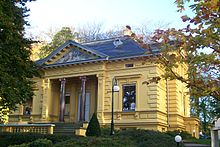Hermann Berthold
August Hermann Berthold (born August 19, 1831 in Berlin ; † December 23, 1904 there ) ran a brass line and type casting company. He unified the typographical point system and adapted it to the metric system; In doing so, he created a uniform font size system for Germany .

Life
Hermann Berthold was born in Berlin in 1831 as the son of a printer. After completing his training as a precision mechanic, Berthold first worked in Paris at the Imperial French Galvanic Institute. In 1858 he founded the Institute for Galvanotype in Berlin. In this copper plates were hardened, electroforming work was carried out for letterpress printing and electroforming was produced. In 1861, in collaboration with G. Zechendorf, Berthold expanded the institute, which was now simply called Zechendorf und Berthold. There was also a type foundry, a brass line factory, and a workshop for stereotyping . However, the collaboration only lasted until 1864.
Then Berthold separated from Zechendorf again and concentrated on the production of brass lines, electroplating and tools. The institute was now called H. Berthold Type Foundry and Brass Line Factory . During this time, Berthold improved a number of printing tools such as the angle hook with a wedge lever lock or the setting ship with a rim made of mahogany wood. For the production of the brass lines, he also developed new tools such as the line planer, with which the line thickness could be precisely influenced. In 1869 Berthold bought his own house in Berlin-Kreuzberg and set up his business there. Through his activities he came to prosperity, which enabled him, in 1883 in the posh seaside Heringsdorf the house Berthold let build that than today Villa Oechsler known and because of the mosaic of Antonio Salviati is of importance to art history.
Until 1878 there was no uniform implementation of the Didot system in Germany. The Europe were very different font heights of the individual printing works. Berthold began developing the typometer in 1878, thus ensuring a uniform system of measurement from 1880. Berthold managed his company until 1888, when A. Selberg was his successor. In December 1904 Hermann Berthold died in his villa in Grunewald and was buried in the local cemetery.
Services
The most important act of Hermann Berthold was the production of the original measure (typometer). Before 1878 there was no uniform writing system. This means that the gradations between font sizes and the height of the font or letters were handled differently in the countries. Some printing works even had their own house height. This made the work of the suppliers of the printing works, such as the type foundries, considerably more difficult. With the help of Professor Wilhelm Foerster , the director of the standard calibration commission, Berthold produced the original size. It is based on the unit meter . One meter corresponds to 2660 typographical points at a temperature of 0 ° C. The German normal system was thus created around 1880. The normal height of the font is then 62 ⅔ typographical points . Now letters, lines and other materials can be produced in uniform dimensions and thus more efficiently for all businesses.
A typometer based on this measurement , a mostly 30 cm long, transparent plastic ruler , is used to measure typographical lengths such as font sizes and line spacing .
Berthold had also made a name for himself with the production of writing lines. In contrast to others, he used brass for production, which provided more stability and precision. He was the first to produce eight-petit lines.
literature
- Severin Corsten, Günther Pflug, among others (Ed.): Lexicon of the entire book system . 2nd Edition. Volume I. Anton Hiersemann, Stuttgart 1987, ISBN 3-7772-8527-7 .
- Karl H. Salzmann: Berthold, August Hermann. In: New German Biography (NDB). Volume 2, Duncker & Humblot, Berlin 1955, ISBN 3-428-00183-4 , p. 166 f. ( Digitized version ).
- Hans-Jürgen Wolf: History of the graphic process. A contribution to the history of technology . Historia Verlag, Dornstadt 1990, ISBN 3-9800257-4-8 .
Web links
| personal data | |
|---|---|
| SURNAME | Berthold, Hermann |
| ALTERNATIVE NAMES | Berthold, August Hermann (full name) |
| BRIEF DESCRIPTION | German entrepreneur and inventor |
| DATE OF BIRTH | August 19, 1831 |
| PLACE OF BIRTH | Berlin |
| DATE OF DEATH | December 23, 1904 |
| Place of death | Berlin |

